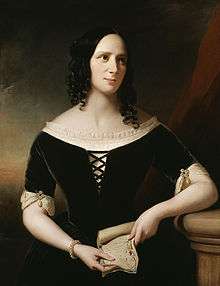Agnes Strickland
| Agnes Strickland | |
|---|---|
 Agnes Strickland by John Hayes, 1846 | |
| Born | 18 July 1796 |
| Died | 8 July 1874 (aged 77) |
| Occupation | Author |
| Genre | History |
Agnes Strickland (18 July 1796 – 8 July 1874) was an English historical writer and poet.
Biography
The daughter of Thomas Strickland and Elizabeth (born Homer) of Reydon Hall, Suffolk, Agnes and her elder sister Elizabeth were educated by their father as if they were boys. Agnes was born at Rotherhithe in Surrey, (she was christened in Rotherhithe on 18th August 1796) where her father was employed as a manager of the Greenland Dock. The family moved to Reydon Hall in 1808.[1] Her siblings were Elizabeth; Sarah; Jane Margaret, Catharine Parr, Susanna Moodie (1803–1885) and Samuel Strickland. All of the children except Sarah eventually became writers.[2]
She began her literary career with a poem, Worcester Field, followed by The Seven Ages of Woman and Demetrius. Abandoning poetry, she produced Historical Tales of Illustrious British Children (1833), The Pilgrims of Walsingham (1835) and Tales and Stories from History (1836). Her chief works, however, are Lives of the Queens of England from the Norman Conquest, and Lives of the Queens of Scotland, and English Princesses, etc.. (8 vols., 1850–1859), Lives of the Bachelor Kings of England (1861), and Letters of Mary Queen of Scots, in some of which she was assisted by her sister Elizabeth. Strickland's researches were laborious and conscientious, and she remains a useful source. Her style is not as objective as most modern historians, but gives a valuable insight into the mores of her own time.
Most of the Strickland sisters' historical research and writing was done by Elizabeth. Elizabeth however refused all publicity and Agnes was put forward as author. Their biographical works are fine representations of the larger body of biographies written by Victorian women, a significant subset of Victorian biography with unique characteristics, including the focus on female subjects and inclusion of information that was more "social" in nature, such as dress, manners, and diet.[3]
Two of her sisters, Susanna Moodie and Catharine Parr Traill, became known for their works about pioneer life in early Canada, where they both emigrated with their husbands in 1832.
Literary works
Biographies
- Lives of the Queens of England. 12 vols., 1840–1848
- The Letters of Mary Queen of Scots. 1842–1843
- Lives of the Queens of Scotland and English Princesses Connected with the Regal Succession of Great Britain. 8 Vols., 1851–1859
- Lives of the Bachelor Kings of England. 1861
- The Lives of the Seven Bishops Committed to the Tower in 1688. Enriched and Illustrated with Personal Letters, Now First Published, from the Bodleian Library. 1866
- Lives of the Tudor Princesses, Including Lady Jane Gray and Her Sisters. 1868
- Lives of the Last Four Princesses of the Royal House of Stuart. 1872
Children's books
- The Moss-House: In Which Many of the Works of Nature Are Rendered a Source of Amusement to Children. 1822
- The Tell-Tell. 1823
- The Aviary; Or, An Agreeable Visit. Intended for Children. 1824
- The Use of Sight: Or, I Wish I Were Julia : Intended for the Amusement and Instruction of Children. 1824
- The Little Tradesman, or, A Peep into English Industry. 1824
- The Young Emigrant. 1826
- The Rival Crusoes, or, The Shipwreck: Also A Voyage to Norway; and The Fisherman's Cottage : Founded on Facts. 1826
- The Juvenile Forget Me Not; Or, Cabinet of Entertainment and Instruction. 1827
- Historic Tales of Illustrious British Children. 1833
- Tales of the School Room. 1835
- Tales and Stories From History. 1836
- Alda, the British Captive. 1841
Sources
- "Stickland, Agnes." British Authors of the Nineteenth Century H. W. Wilson Company, New York, 1936.
- WorldCat.org Accessed 29 June 2007

- Rohan Maitzen, "This Feminine Preserve: Historical Biographies by Victorian Women," Victorian Studies 38, no. 3 (Spring 1995): 371–393.
http://www.suffolkinstitute.org.uk/proceedings-of-the-suffolk-institute-for-archaeology-history-online Vol XXIV Part 1 (1946) "Agnes Strickland and her birth-place" Ernest R Cooper 33 to 35
;Attribution
![]()
References
- ↑ Proceedings of the Suffolk Institute of Archaeology and History Volume XXIV Part I 1946 Agnes Strickland and her birth-place Ernest R Cooper 33 to 35
- ↑ Rosemary Mitchell, ‘Strickland, Agnes (1796–1874)’, Oxford Dictionary of National Biography, Oxford University Press, 2004 accessed 26 May 2015
- ↑ Maitzen, Rohan (Spring 1995). "This Feminine Preserve: Historical Biographies by Victorian Women". Victorian Studies. 38 (3): 971–993.
External links
| Wikimedia Commons has media related to Agnes Strickland. |
| Wikisource has original text related to this article: |
- Works by Agnes Strickland at Project Gutenberg
- Works by Agnes Strickland at Faded Page (Canada)
- Works by or about Agnes Strickland at Internet Archive
- Works by Agnes Strickland at LibriVox (public domain audiobooks)

- Works by Agnes Strickland at Open Library
- Lives of the Queens of England, Vol. 1, 2, 3, 4, 5, 6, 7, 8, 9, 10, 11, 12, 13, 14, 15, 16
- "Archival material relating to Agnes Strickland". UK National Archives.
